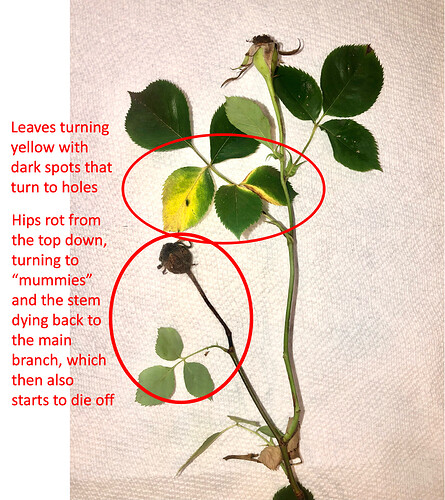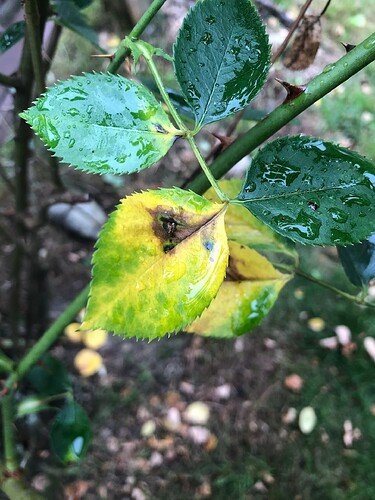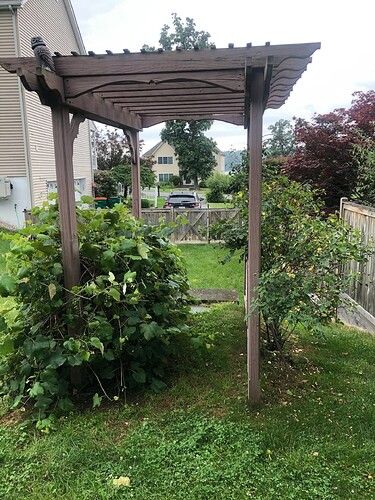Welcome! You don’t indicate where you are, but I’ll guess the nyc may indicate around New York City?
I don’t see anything particularly severe from your photo. The foliage on the right side show the characteristic “window” damage of sawfly larvae, “Rose Slugs” which are small green worms that eat the under sides of the leaves, leaving the cuticle or “skin” of the leaf. If you hold that leaf up to the light, you’ll notice those “holes” appear like small windows covered in wax paper appearing “glass”. The rose slugs LOVE green house conditions…warm, moist, protected, like being in a green house. If the weather dries out; temps get too cold or too hot, they migrate elsewhere. If it remains those mild, humid temps, they will hang around for many generations until winter puts an end to their season. It’s quite possible you’re seeing damage they caused while they were still active. They may not be active now, or you may have not seen them as newly hatched larvae are very tiny and “leaf colored”. If you’re concerned and wish to treat for them, obtain Lady Bugs as they will eat them. If you have used systemic insecticides or intend to use any insecticides, forget the Lady Bugs. Predators are more susceptible to poisons than pests are. Why waste the money and the poor predators?
The rotting hip is perfectly normal after a severe wet period. It’s natural. Flowering is ovulation. Hips are pregnancy. The hip contains seeds. Everything in Nature is programmed to replicate itself before it dies. For those seeds to accomplish their natural “jobs”, something has to eat that hip and ‘spread’ the seed; harvest and plant the seeds; or the hip has to rot, fall off and the seeds germinate where they fall. So, it’s been severely wet where the plant grows. Sap pressure is greatest at the tips of the canes so that hip is full of moisture. There are fungi and mold spores everywhere. True to Nature, the hip is rotting so the seeds can be dispersed. Nothing to worry about. You should remove the rotting hip and the discolored, dying stem beneath it. Cane pieces will die unless there is a viable growth bud at their top ends. If something damages the top bud and the two guard eyes with them, there can be no growth from them so that piece of cane dies back to a point where the cane can grow. If there is a canker or other disease causing the dieback, that can spread farther down the cane than it would normally, so it’s safest to prune off that dying portion to prevent the potential of it spreading farther down the cane.
The white caked coating on the base of the plant sounds like a salt layer. Is this by chance a potted rose? If so, does the pot drain out on a surface or is it in a saucer? Unless it’s distilled, water contains minerals and “salts”. Inorganic fertilizers are ‘salts’ of the nutrients as that is the only form of them the plant is able to absorb. Organics have to be digested into the salt forms of their nutrients by fungi and bacteria for the plants to absorb. If the drainage isn’t sufficient, those ‘salts’ will concentrate and be drawn back to the soil surface as the water is drawn up through evaporation. As it evaporates, it leaves the salts behind in an often white coating.
If it’s in the ground, then perhaps the soil where the plant is isn’t deep so the drainage isn’t great. Salts are being brought to the surface through evaporation. Or, if you’ve applied a pelletized fertilizer, perhaps all that rain has dissolved it quickly and those salts are being drawn up through evaporation?
As long as the main canes are normal colored and not shriveled (still turgid, full of water), the plant is likely in good condition and not in danger. Foliage can be adversely affected by periods of excess water and humidity and the plant still be fine in the long run.
Grapes experience different fungal disease and don’t usually share the same pathogens. Is the “black rot fungus” on the grape on the leaf surfaces? Will the black wipe off with your fingers? I don’t know if you’re familiar with the “disease” Black Sooty Mold, but when there are sucking insects on the under sides of leaves, such as mites, aphids, mealy bugs and others, they suck the sap from the plant tissue, then they release sugar water, “honey dew”, which lands on the surfaces of the leaves beneath them. There is literally a fungus which grows in and feeds on the sugar water called “Black Sooty Mold”. If it’s new enough and hasn’t been there long enough to dry on the leaf surfaces, it can be washed off with a hose. If it’s too dried on, you may have to literally wash the leaves with a wash cloth and running water then rinse. Or you can remove the leaves but then you may encounter sun damage to the grape stems.
I know you’ve just had an extremely wet period, but the most “organic”, least toxic method of getting rid of all the sucking insects on the leaf undersides is to wash them off with a water wand.
You can find them in many big box stores, nurseries, garden centers or on line. Make sure the one you obtain has the water turn off on it so you can prevent waste and wetting yourself with it.
It may take several uses to knock down any infestation of the insects and wash off heavy concentrations of sooty mold, but keep at it. Using it on the rose can also have benefit in removing any of the saw fly larvae still hanging around. Because you possibly live in a high disease pressure area, I’d use the water wand earlier in the day so the foliage has a chance to dry off as the day heats up. If you’ve not had disease issues before, continue your other routines with the rose and grape. Unless you’re using anything systemic on the rose. Any systemic insecticide or fungicide you put in the soil for the rose may potentially be absorbed by grape roots and could possibly cause you and your family to be eating those chemicals in the grapes.
I hope some of this helps you figure out what’s going on with your plants. That’s about all I can come up with from the one photo and your description. Good luck!



